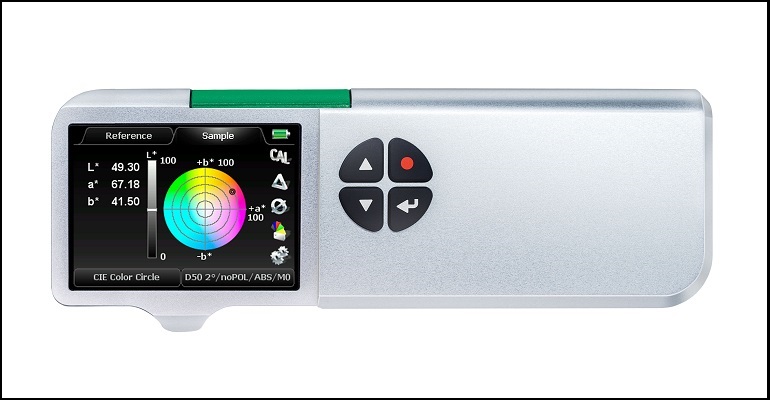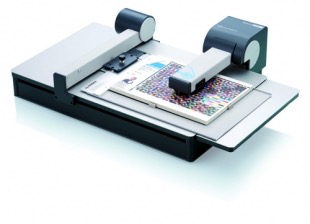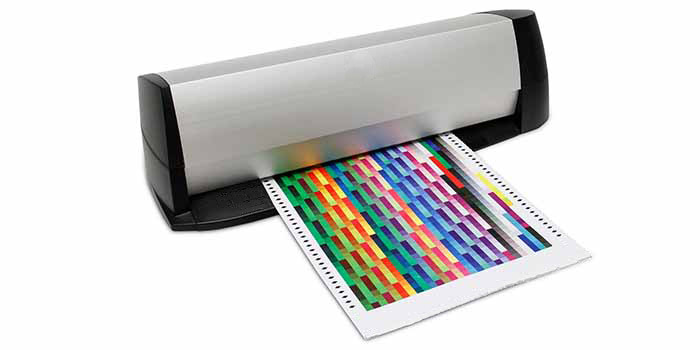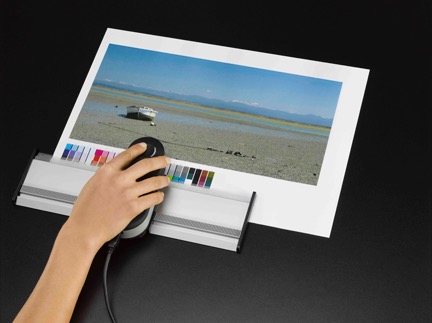Portable / Handheld or Table Top Scanning - Which Spectrophotometer to choose?

Spectrophotometers are widely used to measure and report colour across many indus-tries - printing, photography, industrial areas such as inks, paints, automotive, textiles, architectural coatings just to name a few.
We are going to look at choosing a spectrophotometer for use within printing - covering offset, flexo, digital and wide format print. In these areas the substrate can be paper, carton material (board), flexible packaging material (plastics, polypropylene, etc) and in the wide format area flexible (i.e. self adhesive, banner, etc) or rigid material (screen board, core flute, foam core, etc.)
When deciding which spectrophotometer is right for you there are a number of things to consider.
1) What Sort of Substrates are Going to be Measured?
For ink on paper, sheet-fed offset, heat-set web offset, digital production print and digital proofs, using fairly standard thickness stocks (up to around 400 gsm) a table top automated chart reading (table top) spectro may seem to be the right choice here. But there is another couple of areas to consider as well, which we will cover in the next steps.
If you need to measure rigid type materials, such as "coreflute, foam core, screen board, plastic sheeting", amongst others, a hand held instrument might seem like your only choice. But there are table top spectrophotometers that can measure substrates up to 20mm thick, according to manufacturers specifications. These instruments also offer the ability to measure transparent media, such as 'backlit' material.

What if you need to measure flexible packaging material, like a thin 'polypro' used in flexo printing. You may be able to use either type of spectro here, but you will need to consider the use of a standard 'backing' (white or black) because of the colour show through with this type of substrate.
2) How will You Use Your Spectrophotometer?
Will you be measuring charts for ICC profile colour management? Will you additional-ly need to spot measure or scan 'patches' of colour for QC and QA? Do you need your spectro to work with third party colour management software? Do you require portability? - i.e. taking a hand held to different areas/depts on site or even to other sites?
How you wish to use your spectro may well be the determining factor here...
3) Are the 'Instruments' Going be Part of a 'Workgroup'?
Will all the usage of your instruments be centralised? Or will there be a number of in-struments from across various sites that require correlation with measurement accu-racy?
If say, you are going to use three spectrophotometers across three sites then you should consider using the same type, model and specification. Not only are you deal-ing with one instruments repeatability, you are also have to think about the tolerances of each instrument.
4) Does the Instrument Conform to ISO 13655:2009 for Measurement Modes M0, M1, M2, M3?
This is important for 'print' measurements as quite often the substrate contains an amount of optical brightening agents (OBA's). Many spectrophotometers available now can use the measurement conditions M0, M1, M2, M3.
Many older spectros only used M0 - an incandescent lamp with relative spectral power close to CIE standard illuminant A.
M1 aids in minimising measurement differences between instruments due to OBA's and fluorescence, by matching CIE illuminant D50. ISO 3664:2009 specifies D50 as the standard viewing condition for print, graphic arts and photography.
M2 is similar to the previous usage of a UV Cut filter - to exclude differences in measurement due to fluorescence of OBA's in the substrate.
M3 is essentially the same as M2, but includes a polarising filter to remove and or minimise reflections - also differences between wet and dry inks (dry back).

5) Do You Require Your Spectrophotometer to Measure According to Standards?
The ISO 12647-2:2013 standard states that measurements "should be made using M1". Therefore if you are are using 12647-2:2013, or a later amendment, you should be using M1 mode, with white or black backing.
If you are going to use an in house standard or something specified by your customer or brand owner then this should be clearly communicated stating the illuminant, observer, geometry, backing and /or alternate mode. i.e. M2.
6) What is Your Budget?
I leave this obvious point to last - not that the above points are in any particular order. Price is always going to be a consideration - but the quality of a spectrophotometer will be remembered long after price is forgotten. You need to be realistic here as these are precision instruments that require care and looking after.
You should have your spectrophotometer(s) checked, serviced and re-certified by a reputable instru-ment laboratory or the manufacturer at an interval according to the manufacturer or set by your quality management system policy. Either way it is best practice to have an in-house validation procedure in place, together with records.
So, which spectrophotometer to choose - handheld or table top?
Your choice can be narrowed down depending on how your answer the previous 6 points.

For more information on setting up and looking after Printer Colour Manage-ment, Printer Colour Calibration, on site Colour Consulting and Colour Management training contact us at info@colourgraphicservices.com
